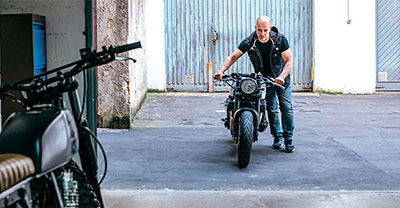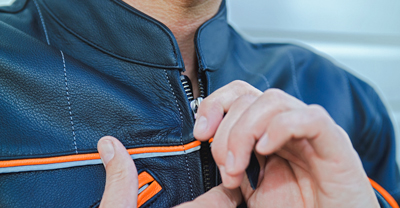Seasonal motorcycle maintenance checklist


Proper motorcycle care is a year-round endeavor. Performing routine inspections, fluid changes, parts replacements, and damage repairs can reduce mid-ride surprises and ensure your bike remains in top shape. Maximize your protection across the miles—whether it’s spring, summer, fall, or winter.
Download our seasonal checklists below for easy reference.
Spring motorcycle maintenance checklist
Here’s what you should keep an eye on in the spring months to keep your motorcycle in tip-top shape.
Inspect and clean your bike

Thoroughly inspect every part of your motorcycle as winter weather subsides. Look for any corrosion, worn parts, or missed damage.
Properly clean your bike, removing debris and road grime buildup from the off-season. Even a motorcycle that’s been stored for the winter can pick up seasonal dirt, so take the time to wash it before your first time out in the spring.
Change your oil and check your fluid levels

Change your engine oil and filter in the spring before you start hitting roads regularly again. Old oil loses essential cleaning and lubrication abilities. Top off brake fluid, transmission fluid, and coolant to ensure proper operating levels.
Inspect your gear

Check your helmet thoroughly for cracks or interior padding breakdown from storage. Replace gloves with worn palm grips or knuckles, and examine riding jackets and pants for tears, ensuring armor remains intact. Consider new boots if the treads seem thin, the ankle padding is worn down, or the hook-and-loop fasteners are too loose.
Summer motorcycle maintenance checklist
Summer comes with higher temperatures and more frequent rides. Check the high-wear components of your bike and be prepared for breakdowns.
Check your tires and brakes

Examine tire tread depth—minimum tread depth for safe summer handling and stopping is 2/32”. Bald tires can be treacherous on sharp turns and wet pavement. Also keep an eye on the air pressure in your tires. Hot air expands, so the pressure that was perfect at normal summer temperatures could cause a blowout on an especially hot day.
Check the brakes of your motorcycle to ensure that each brake prevents the bike from rolling. You can also visually inspect the pads and discs for wear or damage that could degrade performance.
Tune up your engine and check your battery

Tune-ups restore and maintain your motorcycle’s optimal performance. Inspect hoses, belts, plugs, and filters for cracks, warping, and other heat-related damage. If your motorcycle rides especially hot in the summer, consider using a thicker grade of oil—which will maintain its viscosity in higher temperatures.
Heat can be especially hard on your bike’s battery. Testing your battery semi-regularly can ensure strong kick-starting out on the road.
Protect your motorcycle from extreme heat

You can take preventative measures to help protect your motorcycle from extremely hot weather and direct sun. Wax or polish your bike to help reflect heat-causing UV rays. If you can’t park in a shady spot, cover your seat and hand grips so they don’t become too hot to handle when you want to get back on your bike.
On particularly hot days, it’s important for both you and your motorcycle to take regular breaks. As you rehydrate and cool off in the shade, do a quick visual check for signs of overheating.

Fall motorcycle maintenance checklist
Depending on your region, fall’s cooler temperatures, increased precipitation, and falling leaves mark a large maintenance transition for your motorcycle.
Check your brakes and lights

Shorter days mean more night riding, so it’s important that you’re visible on the road. Test all your lights and ensure that directional signals are working correctly.
Decreased visibility can also increase the situations where you need to brake quickly. Inspect your brake pads and monitor your brake fluid. Cold weather can cause brake fluid to contract and let air into the lines. If brakes are feeling spongy, do a full flush and refill.
Check your antifreeze and seals

Antifreeze helps regulate your motorcycle’s temperature year-round, but it’s good practice to check your coolant level to prevent freezing before it gets too cold outside.
Scan your seals and gaskets for any leakage—which could hint at shrinking or hardening as temps drop for the season. Address any worn gaskets immediately.
Inspect your rain gear

Check the waterproofing on your riding gear in preparation for heavier precipitation. If you can see water beads on the surface of your gear when you spray it with water, that’s a good sign.
If you’re getting wet or clammy in your gear, the first step is to wash and dry it. You can then address any tears or open seams with patches, sealant, or seam tape.
Winter motorcycle maintenance checklist
For many riders, colder temperatures mean the end of motorcycle season. If you’re putting your bike away for the winter, you need to prepare it to sit idle. There is also seasonal maintenance if you’re going to ride your motorcycle through the winter.
Guard against snow, ice, and salt

If you’re storing your motorcycle where it’s exposed to the elements, do your best to avoid the worst of winter grime—which when left uncleaned can lead to corrosion, peeling finishes, or electrical shorts. Tightly cover your bike, blocking snowdrift buildup and exposure to plowed snow, road salt, and slush.
If you’re riding in the winter, wash your bike frequently to prevent corrosion from road salt residue. Wax your motorcycle after washing to protect your finish.
Winterize your motorcycle

Before you put your motorcycle into winter storage, fill your fuel tank and treat the gasoline with fuel stabilizer to prevent condensation in the lines. Check all other fluid levels and change the oil and filter after your final ride.
Decide how you’re going to care for your battery. If you’re storing your motorcycle outside, it’s best to remove the battery and keep it in a temperature-controlled location. If your bike is more insulated, you can connect the installed battery to a trickle charger.
Exercise winter riding caution

If you’re riding despite the cold, bundle up! Wear a winter jacket over your armor and waterproof gloves and motorcycle boots to prevent frostbite. You can also add grip covers to pegs to prevent slippery dismounts.
General motorcycle maintenance tips
Consistently performing minor maintenance and scheduled tune-ups helps prevent breakdowns, which saves you money over the life of your motorcycle.
Keep a motorcycle tool kit

Keep a basic set of tools for motorcycle care on hand—including screwdrivers, wrenches, hex keys, pliers, a flashlight, and testing equipment. Also make sure you have specialty tools for your bike model. Refer to your owner’s manual for the full list of tools needed for general upkeep.
Keep your bike clean

Use motorcycle-specific cleaning products like degreasers and aluminum polish that won’t damage finishes or leave a residue. Check your storage space for excess moisture that could do damage over time.
Seek professional servicing

Bring your motorcycle to a certified mechanic annually for diagnostic testing, suspension inspection, and handling assessments. If you lack specialized tools for a repair, notice leaks, or hear abnormal noises, consult a professional immediately.
La información general contenida en este blog tiene únicamente fines informativos o de entretenimiento. Vea el descargo de responsabilidad de nuestro blog.
*La exactitud de los datos está sujeta a la fecha de publicación de este artículo.









